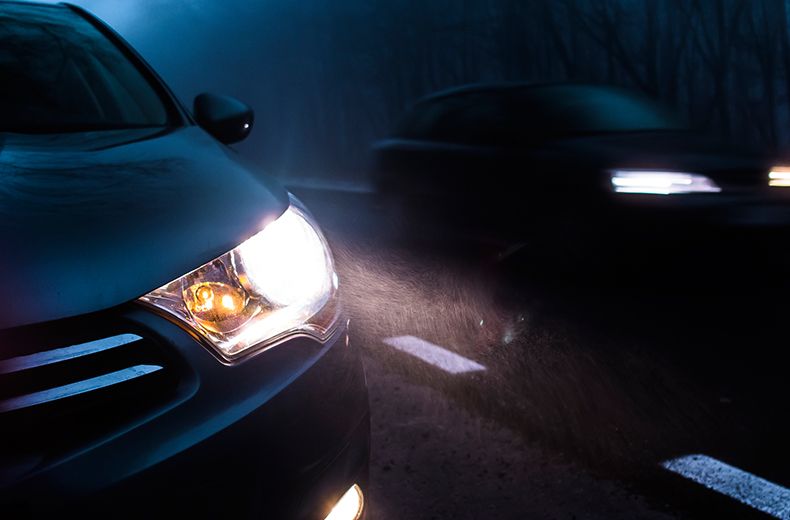Don’t worry, a lot of us need reminding about what our various lights do and when to use them.
Here’s our helpful know how guide to explain everything you need to know about car lights.
What are the different types of lights?
There are several lights on our cars: indicators that double up as hazard lights, tail lights that sit next to brake lights, and headlights that we can set to different modes.
Read on to find out what lights you’ll find on your vehicle and what they do.
Dipped headlights
Dipped headlights are the most commonly used headlights; brighter than sidelights, but not as bright as full beam headlights.
They get their name as they are angled downwards, towards the road. The switch to turn them on is usually found on a dashboard dial or twisted indicator stalk, although many newer cars have running lights that work without input from the driver.
When to use dipped headlights
The highway code says, "You must use headlights when visibility is seriously reduced", with ‘seriously reduced’ defined as when you are able to see less than 100m in front of you.
This means they should be turned on at night-time and during bad weather.
What does the Highway Code say?
Highway Code rule 114:
You MUST NOT use any lights in a way which would dazzle or cause discomfort to other road users, including pedestrians, cyclists and horse riders.
Highway Code rule 115:
You should also use dipped headlights, or dim-dip if fitted, at night in built-up areas and in dull daytime weather, to ensure that you can be seen.
Full beam headlights
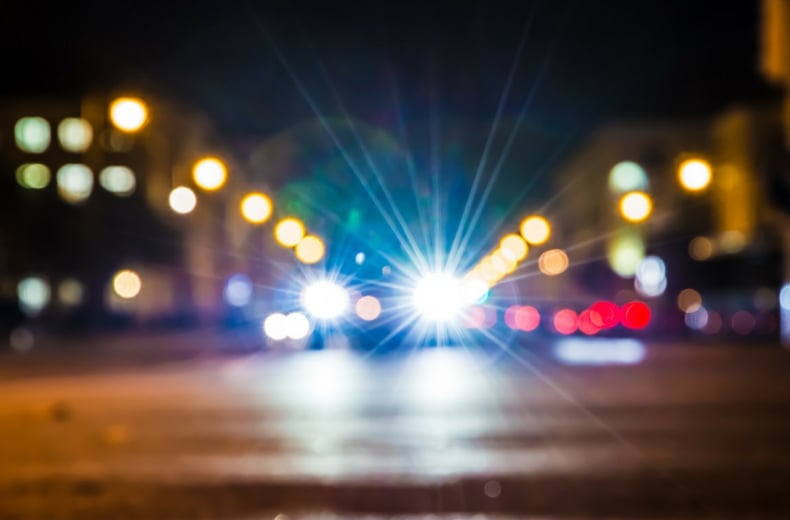
Full beam headlights are the brightest type of headlight on normal vehicles.
They are angled higher than dipped headlights, allowing you to see more of the road, and are sometimes known as high beams.
The switch to turn them on is usually found near the switch for dipped headlights and they may use a different set of bulbs.
When to use high beams
You should only use full beam headlights on unlit stretches of road at night.
When meeting oncoming traffic (including cyclists or pedestrians), following another vehicle, or driving on left-turning bends, you must turn off full beam headlights as they can often be dazzling and may cause accidents.
Fog lights
![]()
Fog lights are designed to cut through fog and mist, unlike full beam lights that are reflected by fog.
They usually come in two sets, front and back, with the switches coloured coded: amber for rear fog lights and green for front fog lights.
In most cars you’ll need to turn your dipped headlights on before pressing or twisting the fog light switch.
When to use fog lights
You should only use your fog lights when visibility is below 100 metres. To use a classic British measurement putting it in perspective: that’s roughly the length of a football pitch.
It’s important not to use your fog lights when visibility is better than that, as you risk dazzling other drivers.
Read more: Driving in fog - when to use fog lights
Hazard warning lights
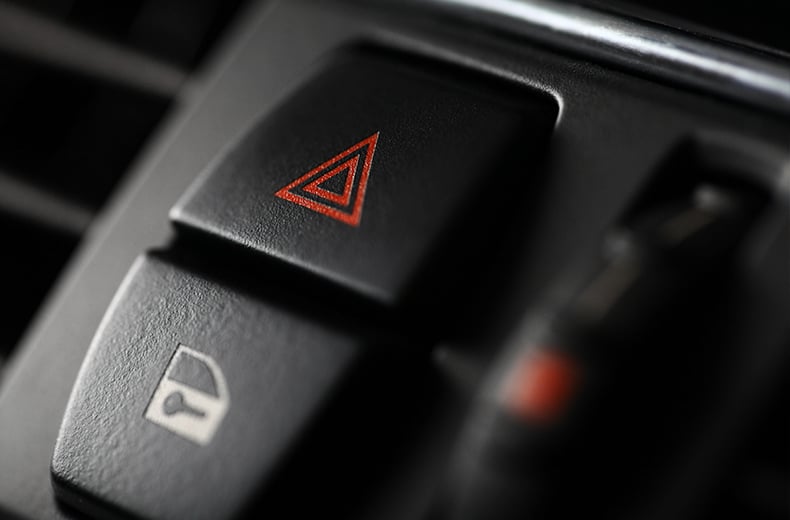
Your hazard lights can be seen at all corners of your car - they’re the lights usually used as your indicators.
The blinking amber lights are used to warn other drivers of danger or obstructions on the road, and the dashboard button is indicated with a triangle shape as shown above.
When to use hazard warning lights
You should only use your hazard lights if your vehicle is stationary, to warn others that you’re causing a temporary obstruction.
This may happen when you’ve had an accident, broken down or been forced to stop by an obstruction.
You may also use your hazard lights if you are on a motorway and there is an obstruction up ahead that you need to warn other drivers about.
Indicators
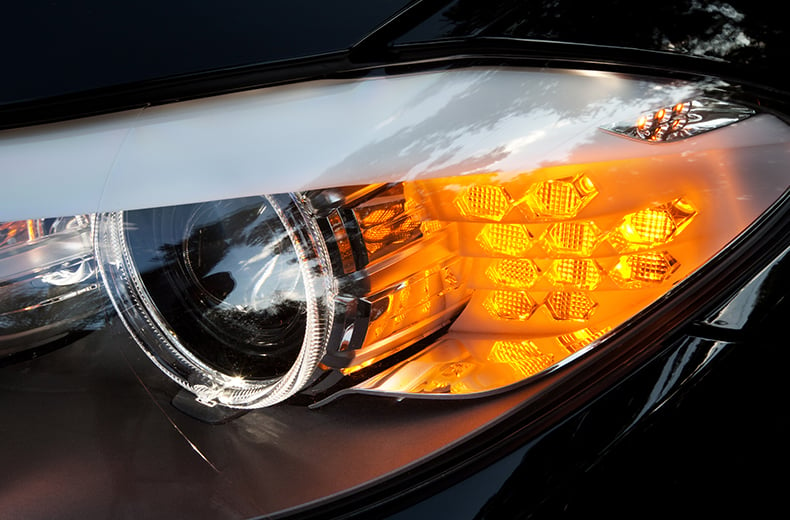
Indicators take up the same position as your hazard warning lights, visible on all corners of your car.
The blinking amber lights are turned on and off down one side of your car using your indicator stalk. They also automatically turn off once you straighten your wheels after making a turn.
When to use indicators
If you've passed your test you definitely shouldn't need to ask this!
You should use indicators to show other road users and pedestrians where you intend to turn. This includes roundabouts, pulling away, overtaking and changing lanes.
Make sure you don’t leave it too late, or turn them on too early, as others might think you’re taking an earlier turning.
Sidelights/parking lights
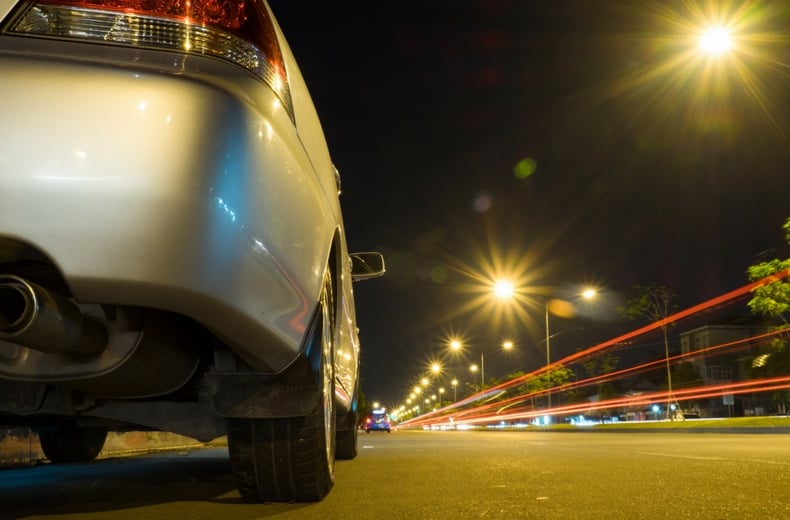
Car sidelights, or parking lights as they are sometimes known, are usually found in the headlamp unit in the front corners of your car.
Sidelights aren’t as bright as headlights, so are used by drivers to make themselves visible to traffic during times when it’s not dark enough for main lights.
The switch to turn them on is usually found on a dashboard dial or twisted indicator stalk.
When to use sidelights/parking lights
The Highway Code says that all vehicles must display parking lights or sidelights when parked on a road (or lay-by) with a speed limit over 30mph. They are designed to be left on for long periods of time when you leave your car and shouldn’t drain your battery.
If the road has a speed limit of 30mph or less, you don’t need to use your sidelights, as long as:
- your spot is a recognised parking bay or lay-by, or
- you’re facing in the direction of the traffic flow, close to the kerb, and at least 10 metres from the nearest junction
Sidelights must also be switched on if your vehicle, for unavoidable reasons, is parked on any road in fog.
Read more: Parking lights – what are they and when should I use them?
Are sidelights tested in an MOT check?
Yes, sidelights are tested during an MOT (Ministry of Transport) test in the UK. The test ensures that the sidelights are functioning correctly, are of the correct brightness, and that both the left and right lights are working.
A mechanic will check that the lights are positioned correctly and that there are no faults, such as a blown bulb or incorrect alignment.
If your sidelights aren't working properly, they may fail the MOT.
Sidelight bulbs
5W bulbsare the most common bulbs used for sidelights in many vehicles. They are small, specialised bulbs that come in various colors, though white is standard for most modern cars.
Tail lights
Tail lights are red and found on the back of your car. They’re turned on/off at the same time as your headlights.
So, whether you manually turn on your headlights or they work automatically, they will illuminate either way.

Breakdown cover that’s cheaper than AA – from £5.49 for Roadside!*
Complete peace of mind for less
• Cheaper than AA Price Guarantee^
• We get to most breakdowns in 60 mins or less
• Our patrols fix 4/5 breakdowns on the spot

Brake lights
Brake lights are also red and are located near your tail lights. They illuminate to show other drivers that you’ve applied your brakes and are slowing down.
You should make sure they’re kept clean and working at all times. Aside from the safety risks involved, a faulty brake light could see you pulled over by the police and given:
- A verbal warning
- A fixed penalty notice – including a £60 fine and three points on your licence
- A Vehicle Defect Rectification Notice – 14-day order to fix the fault and provide proof of the fix
In serious circumstances your car could even be taken off the road immediately.
Car headlight bulb types
With cars changing like never before, it’s no surprise that their lights are also evolving.
As manufacturers consider the environmental impact of their work, energy efficient solutions have become more popular on our vehicles. Advances in technology have given us three common bulb types:
- halogen
- light emitting diodes (LED)
- xenon/high intensity discharge (HID)
Halogen headlights
Halogen lights are the most popular kind on our roads today. They use a combination of gases - usually nitrogen and argon – and a tungsten filament in a glass tube.
Once the filament is heated, light is produced. They are cheap and easy to replace, but have fallen out of favour in recent years.
A standard Halogen bulb will produce 1300 Lumen, a good level of light but dimmer than other options.
The unnecessary and unused heat generated by halogen makes it incredibly inefficient and as light isn’t focused, illumination of the road isn’t as bright as it could be.
LED headlights
LED stands for ‘light emitting diodes’ and is currently the most energy efficient system widely available.
With a short rise time – the time it takes to turn on – they work over 250 times faster than halogen, making them very suitable for brake and indicator lights.
The long-lasting light source is small and can be arranged into a variety of designs, which gives manufacturers a lot more flexibility with their designs. These directional lights are brighter than halogen bulbs of the same wattage as well.
LEDs produce a small amount of heat at the emitter when electricity passes through and require cooling systems to avoid damage to nearby cables. Cooling systems are generally positioned in the engine bay.
With a number of human-made components, LEDs are expensive in comparison to halogen bulbs.
Xenon headlights
Xenon high intensity discharge (HID) headlights heat gases and rare metals to generate a bright white or blue glow.
They are up to three times brighter than halogen bulbs with the same wattage. HID lamps need more power to start up than halogen but operate at a much lower power usage, with a greater lifespan.
HID headlights are very distinctive when you see them out on the road, but they’ve failed to become an industry standard for a few reasons. Among these are the cost of the rare metals needed to produce them, their brightness which can cause glare for other drivers, and the time they take to reach full brightness.
There you have it: more information about car lights than you'll probably ever need. Want to make sure yours all work? Here's how:
Get 30 driving tips that will save you money
Running a car isn’t cheap, but there are some easy things you can do to keep your costs down. Get these tips and more useful driving articles sent straight to your inbox now.


If you are looking to replace the bulbs within any of your car's lights, we stock a wide range over at the RAC Shop.

